

By
Don and Linda Freedman
Search TheTravelzine
TheTravelzine Group
Access Your Mail
Don's Gallery
Packing Hints
Planning Tips
Cities Links
Links
LINKS TO OUR TRAVELOGUES
Argentina, Buenos Aires - Jan-Mar 2010
Argentina, Buenos Aires - Jan-Mar 2009
Argentina, Buenos Aires - Jan-Mar 2008
Austria - Fall 2005
Belgium, Brussels - Fall 2000
Canada - Summer 2002
Canada - Summer 2001
Canada - Summer 2000
Czech Republic - Spring 2000
France - Fall 2002
France, Paris - Fall 2000
France, Paris - Spring 1999
France, Lyon - Spring 1999
Germany, Berlin - Fall 2009
Germany - Fall 2002
Germany - Spring 2000
Germany - Fall 1999
Greece - Fall 2012
Greece - Fall 1999
Greece - Fall 1997
Hungary - Spring 2000
Israel - Fall 1999
Italy - Winter 2007
Italy - Winter 2006
Italy - Winter 2005
Italy - Winter 2004
Italy - Winter 2003
Italy - Winter 2001
Italy - Fall 1998
Italy - Fall 1996
Netherlands - Spring 2000
Portugal, Azores - 2019
Portugal, Azores - 2018
Portugal, Sao Miguel & Lisbon - 2017
Portugal, Azores - 2017
Portugal, Azores - 2016
Portugal, Azores - 2015
Portugal, Azores - 2014
Portugal, Azores - 2013
Portugal, Azores - 2012
Portugal, Azores - 2011
Portugal, Lisbon - 2011
Portugal - Fall 2006
Portugal - Fall 2004
Portugal - Fall 2003
Portugal - Fall 2001
Portugal - Spring 1999
Portugal - Spring 1997
Slovakia - Spring 2000
Slovenia - Spring 1999
Slovenia - Fall 1996
Spain, Barcelona - Winter 2006
Switzerland - Fall 2002
Switzerland - Spring 2000
Switzerland - Spring 1999
Switzerland - Fall 1998
Switzerland - Fall 1997
Switzerland - Spring 1996
U.S. Florida, Key West - Fall 2006
U.S. Florida - Spring 2001
U.S. Maine - Summer 2002
U.S. Massachusetts - Summer 2003
U.S. Massachusetts - Summer 2002
U.S. Massachusetts - Summer 2001
U.S. New York State - Fall 2005
U.S. New York State - Summer 2004
U.S. New York State - Summer 2003
U.S. New York State - Summer 2001
U.S. Washington,DC - Spring 2000
PORTUGAL
FALL 2006
Porto | Cascais
| Portel
| Lisboa
São Miguel, Azores
Our first visit to the Azores, Portugal's 9-island archipelago in the middle of the Atlantic Ocean, was in 2003. We explored four of the islands and were particularly enraptured by the largest of the group, Sao Miguel. We were so impressed, we knew it was just a matter of time before we'd return to "dig deeper", as the Portuguese Tourism Office suggests.
All aboard SATA flight S4 125 from Lisboa to Ponta Delgada, the largest city on the island capital of the Azores!
It was a perfect flight - efficient check-in, a pleasant flight crew, wide leather seats, good leg room, an excellent chicken sandwich, ice cream, ample beverage choices. Two hours and twenty minutes flew by and our luggage arrived promptly and intact.
We are fortunate in Toronto to have
direct SATA INTERNATIONAL flights to mainland Portugal and the Azores.
SATA also offers excellent service between the islands.
Since it is only a six hour flight from Ponta Delgada to
Toronto, and the time difference is only four hours, we
planned our visit for our return trip, to make our jetlag
transition easier. 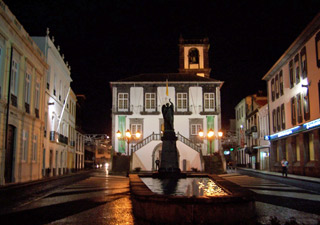
Sao Miguel was formed by a series of volcanic eruptions which created an island in the east. This was followed by the emergence of a volcanic massif in the west, which formed a second island, separated from the first by a channel. The two eventually merged to form the present island which is 81 km long and 15.5 km wide at its maximum points, for a total of 746.76 square km.
Driving is the best way to explore the island, which is served by an excellent road network. We do not like to drive and our goal was to become acquainted with all that we had not experienced on our previous visit. To this end we engaged a highly recommended guide/driver to work with us. Ana Silva, mailto:saouto@hotmail.com (tel.,+351 296 498 787, cell,+351 969 721 735), who picked us up at the airport. She had read our 2003 travelogue and was prepared with a complementary itinerary. We suggest that you read our previous travelogue for the complete picture of all that San Miguel has to offer.
Ana has lived and worked here her entire life as has her family. She loves her island and her unbridled energy, enthusiasm and ability to communicate brought meaning and life to all we shared.
Since the driving distances are short we chose to stay all six nights in Ponta Delgada at Hotel do Colegio, located in the center of the city. The building was originally a school, which Fernando Neves, the hotel owner, attended as boy. A showcase in the lounge contains the mementos of his days as a student there. More recently the building served as the musical academy of the Regional Conservatory. At first sight it was easy to understand why the building has been classified as architecturally and culturally valuable. The design of the main doors, windows, staircase, archways and stone slab flooring are beautiful renditions of the typical masonry and local basalt work. Just inside the main door is a platform which was used to mount a horse and a place in the wall to wipe off boots.
Across the way, centered in an archway leading to the reception lounge, is a tribute to the musical heritage in the form of a graceful sculpture of a cello. There is a piano in the bar/breakfast room and it is not uncommon for guests to play and sing. The guest rooms are named for traditional Azorean musical compositions.
The swimming pool in the center atrium is a lovely focal point from all the public areas of the ground floor as well as the rooms above.
It's a homey environment. Fernando is your host, constantly checking, inspecting and assuring all his guests that he and his staff are there for their needs and comfort. Next to the Internet point at reception are volumes filled with glowing compliments written by former guests from around the world.
Our large twin-bedded room was
comfortably furnished with an abundance of fresh air and
light courtesy of huge windows that opened onto the
atrium. The tile bathroom was generous in size and well
equipped with quality essentials. 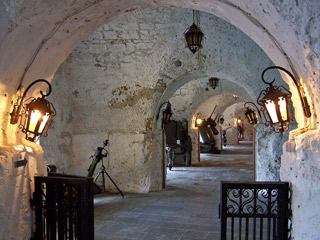
Ana suggested we spend the rest of
the afternoon visiting the Military Museum of Azores
located in the Forte de Sao Bras on the waterfront just
west of the city center, a 10-15 minute walk from the
hotel. The M.M.A. was created the 26th of February l993
but only started activities this year. It's a military
facility. "The mission is to collect, preserve and
exhibit artifacts related to the military history of
Azores thus preserving the heritage and providing a
better understanding of the history".
[Back
to Top]
The exhibit starts with uniforms and artillery. A tunnel leads to an array of weapons from heavy machine guns to handguns. The last rooms are dedicated to engineering, military communications, health, anti car weapons and supply service. The equipment is well-preserved, a treasure for military buffs. The fortress walls offered views of the port, harbor and city.
Last trip we had two fabulous meals at Acores Marisqueira, Rua Eng. Jose Cordeiro 20 so we could hardly wait to return. A bottle of Terras de Lava white from the island of Pico was as full of fruity flavor and crispness as we remembered. We followed the house-offered appetizer of fried breaded beef rolls with a portion of the Azorean specialty, cracas. Succulent and fun to eat, the barnacles are boiled in natural salt water with a zing of hot pepper then you use special picks to pluck the delicate white-fleshed treasures from their tube-like hiding places.
We were having trouble deciding on our next course so our waiter suggested that Linda have a house specialty, steak topped with an egg, fries and salad and I, tuna steak with boiled potato and salad. We were off to a good start!
We were up early and found Fernando busily making sure that the buffet breakfast had been properly presented and the staff ready to go. Local products dominated the offerings. The cheese from the island of St. Jorge is famous for its smooth texture and slightly spicy flavor, fame well deserved. Of course the fresh white goat cheese from Sao Miguel is no slouch. The fresh bread and rolls, scrambled eggs, meats, banana cake and jams were a treat and for the health-conscious fresh fruit salad, cereals and yogurt were plentiful. Splendid way to start the day!
King Alfonso V ordered the colonization of Sao Miguel in 1439. The capital was established in Vila Franca do Campo, in the middle of the southern coast, because it had the best harbor conditions and was surrounded by fertile land. The search for fertile land along the coast led to settlement of Ponta Delgada, west of Vila Franca do Campo, and Ribeira Grande in the middle of the northern coast.
The first inhabitants were recruited from mainland Portugal from Estremadura, Alto Alentejo and the Algarve. Offers of land and trade attracted people from Madeira, Jews from around the world and Moroccan noblemen. The island's geographical location between Europe, Africa and America and its fertile soil contributed to rapid economic expansion. Wheat and woad, an herb from the mustard family from which a bright blue dye for textiles was made, were the major crops. From 1522 to 1640 there were numerous setbacks: earthquakes, eruptions, Spanish influence, and pirates.
Portugal recovered its independence
in 1640 and new opportunities opened for Sao Miguel.
Unfortunately the woad business was replaced worldwide by
indigo from the Americas. Oranges became the new economic
engine with crops peaking from 1860 to 1869. More bad
luck, the orange trees were wiped out by disease. The
consequence was serious emigration. 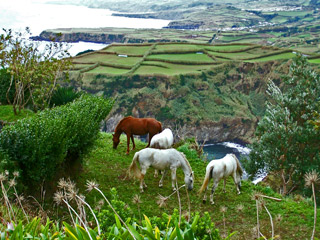
The farmers fought back with crops
of tobacco, pineapples, sweet potato (for distilling
alcohol), esparto (for rope), tea, passion fruit etc.. An
artificial harbor was created in Ponta Delgada which
brought new industries and there was growth in fishing
and cattle farming. Today the major industries are dairy
and tourism while pineapple-growing and tea plantations
continue to flourish.
[Back
to Top]
Sao Miguel is shaped like a whale, the south shore its belly. All around the rocky coastline are villages and towns resting amongst fertile farm and grazing land decorated with stunning Azorean flora. Down to the sea are adorable fishing villages and beaches. Whitewashed houses with black volcanic rock-trim dot the landscape and line the narrow streets overlooking the sparkling blue sea from every angle. Sao Miguel was recently awarded a citation for the quality of its beaches and waters by the EU.
Inland are deep blue and green lakes surrounded by exotic, lush plantings - Lagoa das Setes Cidades to the west, Lagoa do Fogo and Lagoa deo Congro in the middle and Lagoa das Furnas to the east. Incredible volcanic craters await your visit and if its height you desire, just wind your way up 1103m to the top of Pico da Vara. Drive the roads and thrill at the deep green valleys tiered with farms and gushing waterfalls.
Today we would drive east along the shore as far as Ribeira Grande on the north shore and return southwest to Ponta Delgada. There are "Miradouros" (viewpoints) all along the coasts which offer spectacular views of the coastline and surrounding countryside.
After a brief stop at the viewpoint overlooking the enchanting village of Caloura, to which we would return, we passed by Lagoa da Furnas and followed the road to Ribeira Quente, a lovely fishing village with homes stacked on the hillside tumbling to a wide bay. The road is framed by waterfalls turned yellow by dissolved minerals as it passes through green vegetation, a sight to behold. A deep valley carries a stream of water from the hot springs (calderas) of Furnas through the village to the sea.
The road to Provoacao, the island's first settlement, winds through luxuriant vegetation, rushing streams and a postcard-worthy water mill. Seven parishes on seven hills form the village with narrow streets lined with white houses at the center crossed by three streams that run down to the sea. Palames, a dark sand beach, is on one side and Morro beach is on the other. The Church of Nossa Senhora do Rosario (Our Lady of the Rosary) is one of the oldest on the island. Although the design is much the same as every other church, the decorative basalt trim on the facade and the setting make this one picture perfect. There is a memorial to the 1432 settlement of Povoacao in the middle of a park in the center of town.
Heading north to Nordeste along twisting forested roads and steep valleys, we stopped at three viewpoints. Ponta da Madrugada, viewpoint of the dawn, is famous for viewing the sun rise. We were late for that but the coastline and sea panorama is spectacular. Miradouro da Ponta do Sossego is laid out as a garden with a neat picnic area surrounded by hydrangeas and azaleas. This is an enchanting spot to enjoy nature and the sea with glimpses of a nearby rural village, Lomba de Pedereira. Ponta do Arnel offers a marvelous photo opportunity of an adorable lighthouse jutting out on a point below.
The greens of the forests and farmlands surrounding Nordeste are carried into the parks of the town, giving added warmth to the rural architecture. Ana told us that Nordeste had received an award for the best kept flowers in the EU.
The Restaurante Esplanada overlooks the splendor of the striking Ponte de Sete Arcos, 7 arch bridge, built in 1882. The menu features traditional local favorites at reasonable prices. We started with crusty rolls, fresh white cheese and pimentos which add a pleasant kick. We ordered cozida of Abrotea, the fish of the day, which is boiled with potatoes and served with salad. The tender white fish was fresh and one order was ample for sharing - a delicious lunch.
Moving west along the north coast
the landscape is breathtaking. The deep green valleys are
tiered with farm land, dotted by homes; waterfalls tumble
down amongst lush, colorful vegetation creating magical
pools and the occasional water mill adds to the
unforgettable vistas. 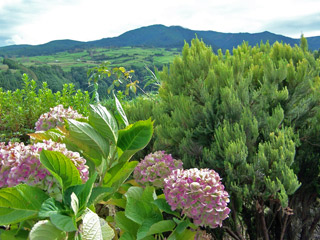
The plants, flowers and trees at
the viewpoint Despe-te-que-suas are reason enough to stop
but even more so with the contrasting rocky coastline,
rolling meadowlands and Pico da Vara (the highest
mountain). Etched in my memory are the magnificent
indigenous plants and flowers that grace the mountains,
the yellow Ginger Lilies and always the blue-green sea.
[Back
to Top]
One glorious treat after another - Parque Natural da Ribeira dos Caldeiroes, Linda's digital is working overtime with all this beauty. Waterfalls flow through ferns and palm trees, plants and flowers, splashing onto rocks and under bridges to an exhibition wheat mill near a pond nestled between the walking paths.
Westward ho! to Miradouro do Salto da Farinha-Queda de Agua, where a path leads down a steep incline to the beach below. We stayed up top admiring the two waterfalls cascading down into natural pools at the base, the twists and turns of the coastline and the sea. A welcoming picnic area awaits those so inclined.
Nearby, at a high altitude, sits the village of Salga (salt) so named for its historical purpose as the place to which pork was brought to be salted and stored until needed.
Fishing has always been important along the northern coast and villages with small harbors are home to graceful fishing boats. Porto Formoso is such a village, with the added attraction of the very popular Mill Beach. We were looking forward to a coffee break at the attractive cafe on the beach but unfortunately it was closed this day. The old mill for which the beach is named has been transformed into a summer residence. Renovating mills, old homes, building new is happening all over the island as people from Ponta Delgada, the mainland and overseas are finding happiness by the shores of Sao Miguel. Linda disappeared for a few minutes and we found her snapping away at a newborn family of ducks - very cute, the ducklings and my wife.
Just down the road is the Miradouro de Santa Iria which is surrounded by wide pastures where cows and horses graze on natural grass overlooking the emerald green, white-capped sea. Contented, well fed cows that live outdoors year round provide tender, tasty meat we'd be savoring at dinner. Grilled beef steak of various cuts is very popular and is on every menu of every restaurant. We skipped Ribeira Grande and headed southwest, back to Ponta Delgada.
At Ana's suggestion, we tried Bar-Restaurante Alianca, Rua Acoreano Oriental, 19/23. We sat in the ground level dining room, which was filled with locals. The menu offered a good selection of reasonably-priced fish and meat dishes. We started with the daily soup, tasty tomato-vegetable, and shared the Bife Alianca, the signature thick cut of beef grilled medium rare as requested, strewn with whole garlic cloves and grilled red peppers - delicious. Monte Velho red from Alentejo was a solid choice, medium dry and fruity.
After our breakfast fix of Sao Jorge cheese and fresh bread we again headed east along the south shore. As we passed through the village of Populo we were intrigued by the elegant homes and pretty beach. We had bought a ticket for the Euro Millions Lottery (113 million euros) and prayed we'd be back to put in an offer on one of the villas. The next village of Altahada, no slouch either, was worthy of consideration as well. Always dreaming..........
We had asked Ana to see if she could arrange to show us some rural rental accommodations that could be considered for a future visit. The first was just up the road at the eastern end of the town of Lagoa. Casa do Termo, mail to:willem.rieff@cmjrieff.pt at Estrada Regional, #1, Santa Cruz.
The property is surrounded by a
garden and semi-tropical fruit trees and grazing land
down to the coast. They keep cows and fresh milk is
available daily. The original house, dating to the 18th
century and refurbished in the 20th, has 5 bedrooms, each
with its own bathroom, sitting rooms, living room,
kitchen and a large patio facing the sea. Two other
recently-completed buildings, one an updated traditional
design the other more contemporary, both completely
equipped for self-catering, offer two bedrooms and
bathrooms each. Any one of them would be ideal. 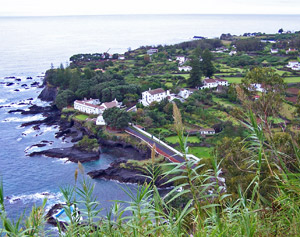
[Back
to Top]
Next, Caloura, an isolated paradise of calm and beauty situated on the southernmost point of Sao Miguel. Stunning white houses resting on manicured properties and vineyards defined by black stone walls lead to a small fishing port and two beaches nestled between cliffs with a natural swimming pool formed by the rocks. Beautifully designed homes and resort hotels sit along the sloping rocky coast and what a sight it was with the waves smashing against the rocks and the sprays sparkling in the sunlight. This would be our first fantasy stop of the day!
The Caloura Cultural Center is located in Canado do Castelo in the village of Caloura. We stepped out of the car and entered a garden of Eden. The fresh air was laced with pleasing scents of the lovingly cared for flowers and plants. It was intoxicating. The modern building is situated on land divided by traditional stone walls that served to protects vineyards in bygone days.
The artist Tomaz Sousa Borba Viera conceived this project to exhibit his private collection with the aim of communicating a better understanding of all works of art. The permanent collection will alter over time with new pieces and work of other artists. There is reference material about the artists on exhibition as well as cultural and artistic information in various forms. Books and audio material are offered in the shop, which has Internet access area and there's tea service as well. The center has been open for only one year and is part of an effort to decentralize culture which is usually based in urban centers. The entrance fee is just one euro, with 50% discount for students.
Ribeira Cha was recognized as a village on the 18th of May, 1966. It belongs to the Parish of Lagoa. It is home to the Museum of Agriculture and the Museum of Ethnographic and Religious Arts which together are a capsule of the history and culture of Azorean life. It was a pleasure to spend time with the enthusiastic folks responsible for the project who are rightly proud of their accomplishment.
The exhibits are real - displayed in typical period buildings. There's an array of plants and ancient herbal remedies and information about the uses. We saw and learned the history of the famous "woad" plant (cultura do Pastel) that made and then destroyed the economy. There is a large display of cana (cane) and corn husk products which were popular crafts. The first machine for threshing wheat, grape presser and masher, wood barrels, and lagar (for stomping grapes) and other agricultural utensils provided insight as to how hard the labor was to get the crops planted, cultivated, and processed.
Most interesting and fun is a series of small wooden buildings depicting various professions, each displaying the tools-of-the-trade, donated by local people, that a shoemaker, barber, dentist, carpenter, weaver, etc. would have used. An original outhouse gave new meaning to the words, "I'll wait till I get home".
There is a day center for elders, where women do handicrafts and the men play cards and smoke. At the end of the day it's coffee and goodies for all.
We visited the show house of an Azorean lady who grew up in the U.S. and returned here to marry. Her home has been preserved with its original furnishings. The bedroom, kitchen-living room are on the ground floor and the children’s sleeping quarters, complete with a corn husk mattress, are in the attic along with a play area and a collection of trunks.
Next to the church is the religious museum with a marvelous collection of clay miniatures in colorful costumes depicting historical and religious events. There is also a collection of period clothing, religious art and artifacts.
All these Ribeira Cha museums can
be visited with free guided tours so take advantage of
the opportunity. 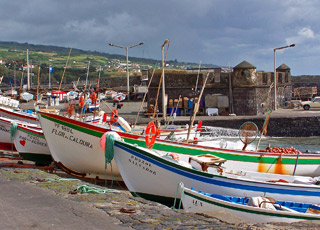
We visited Vila Franca do Campo in 2003 and today just stopped at the fishing port to admire the colorful boats and the walls of Fort Tagarete, a remnant of the many fortifications that defended the coast and the town. The main reason we were here was to have lunch at one of the town's favorite restaurants, O Jaime. The owner is as bright and cheerful as the décor, arched white walls, green tiles and tree stumps imbedded in the ceiling.
We shared a platter of outstanding grilled swordfish and a fish that is reddish in color with huge round eyes whose name I can't recall, but its tender flesh and sweet flavor I do remember. As usual, the sides of boiled potatoes and mixed salad were generously presented. We passed on dessert but the boss insisted we try the local sweet, Quei Jada de Vila Franca do Campo - quite delicious - try it!
We scooted up north stopping at Telelagem O Linho, Estrada Regional 17-A, Lombinha da Maia. A precious home of volcanic stone houses a family weaving business. Husband and wife work old wooden hand looms as well as a computerized version of one, making decorative mats, blankets, carpets, scarves etc. They also operate a small cafe in which we found an OLA freezer chest and two Magnum Classics (the best chocolate covered ice cream bars in the world). Have I failed to mention that we have a Magnum Classic a day when we are in Portugal?
Caldeiras da Ribeira Grande, not
far from Ribeira Grande, is an ancient hot springs and
thermal station complex (open only in the summer) that
looked like a nice, quiet spot for a relaxing soaking
experience. 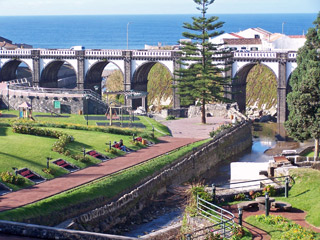
The story of Ribeira Grande is
water. The stream of water fed by the deep crater of
Lombadas that runs through the town to the sea led to the
creation of the water mill industry and the early
economic prosperity and growth. In the middle of the city,
stone channels indicate the location of former mills near
the pretty Jardim do Paraiso. The sea, waves breaking on
the pebbled beaches, swimming pools, surfing, fishing, is
a year-round playground for residents and visitors.
[Back
to Top]
Walk through the streets of Ribeira Grande. Note the mansions decorated with architectural highlights around doors and windows, such as raised diamond points, the Town Hall, Parish Church and Baroque inspired Church of Espirito Santo with its two doorways, and the omnipresent sea views.
Before we left this morning, we made reservations (necessary) at the hotel restaurant, A Colmeia, popular with guests and local patrons. Now we were seated at a table in the no smoking section (a treat!) overlooking the atrium and pool. The relaxing contemporary design in rust and gold, pleasant unhurried service and excellent cuisine was a formula for a delightful evening. It was not long before we spotted our host, Fernando, working the room, cheerfully ensuring all was as it should be.
The house offered delicious egg and spinach in aspic to start. Linda ordered a light meal (classic case of Ola Magnum Classic guilt) of caldo rico de peixe (rich seafood soup) and salada a Colegio com frango (mixed salad with chicken). I had sweet potato soup and grilled swordfish with capers and tomatoes. The house white wine was quite nice as was the house-offered Chico Maria dessert wine from Terceira.
It is believed, though undocumented, that the Jewish people came to the Azores during the 15th and l6th centuries. The first documented settlement began in 1818 with the largest community in Ponta Delgada. Between the inquisition and the second world war Jews were forced to convert to the Catholic faith to survive. Today there are no Jews on Sao Miguel, but there is the Sahar Hassamain Synagogue, located in the downtown center on Rua do Brum, 14-16.
Ana was able to arrange a visit. We met José de Mello, a city hall employee, who has recently been given the responsibility of coordinating efforts to restore the synagogue. Other than a partial repair and restoration of the façade, windows and roof, nothing has ever been done to restore and preserve this historic and cultural institution. What we saw brought tears and anger. Pure hell. Termites have been feasting. Water has been pouring through holes in the walls and ceilings; stairways, floors and window casings are rotting. The place is on the verge of collapse.
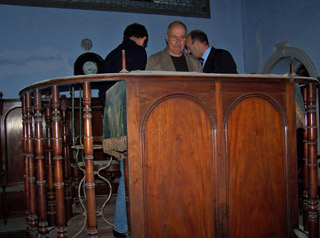 The sanctuary with
its beautiful arc, bima and dark wooden benches is
located behind living quarters on the first floor. Light
from the windows of the balcony and the high ceiling
should offer the feeling of tranquility one expects at a
house of worship. But in this case, the light reveals the
utter shame of neglect and total disregard for the
ceremonial and religious objects. We lifted the seats of
the benches where we found talesim, telfilin and prayer
books covered with rodent droppings, mold and dirt. We
found untold documents in similar condition in cabinets
and drawers. It is a disgrace, literally a "crying
shame".
The sanctuary with
its beautiful arc, bima and dark wooden benches is
located behind living quarters on the first floor. Light
from the windows of the balcony and the high ceiling
should offer the feeling of tranquility one expects at a
house of worship. But in this case, the light reveals the
utter shame of neglect and total disregard for the
ceremonial and religious objects. We lifted the seats of
the benches where we found talesim, telfilin and prayer
books covered with rodent droppings, mold and dirt. We
found untold documents in similar condition in cabinets
and drawers. It is a disgrace, literally a "crying
shame".
The official explanation is that the government has never been able to establish ownership of the property and it is not legally possible to issue approvals for restoration or allocate funds to other than a legal owner of a property. Apparently this issue has now been resolved. The Jewish Community of Lisbon and the Cultural Commission of Ponta Delgada have formed a committee to discuss funding and planning an eventual restoration, estimated to cost half a million euro. It remains to be seen how long it will take for the funds to materialize and the project to get underway.
Ana picked up the key to the Jewish
Cemetery, located on Rua Santa Clara surrounded by a
concrete wall and an outer wall of an abandoned fish
factory. Approximately 160 souls are buried around a
large overgrown cactus under marble monuments, some
disintegrating, amongst litter and weeds. It saddened us.
[Back
to Top]
We were in the city center looking for a lunch spot and discovered A Comercial at Rua Machado dos Santos, 73, where locals were lined-up making selections at a hot table. This place became our favorite lunch spot in Ponta Delgada. Fish and meat daily specials with potato, rice, salad, plus daily soups (chunky chicken soup) and rice pudding were all cheap and delicious.
As dairy is a major industry, we requested a visit to the Unileite Dairy, a cooperative of 740 members, which celebrated its 50th anniversary in 2004. In 2005 Unileite produced 25.5 million liters of milk, 2 million kg. of cheese and 1 1/3 million kg. of butter. They also bottle many kinds of juices. The factory is fully computerized. Cleanliness is essential and rigorously maintained. We looked cute in our white bonnets, smocks and blue shoe covers. The major production takes place between March and July. Grazing cows all over the island insure an abundant supply of top quality product which is monitored at every stage of production. We enjoyed a sampling of their cheeses at the end of the tour.
Colegio 27, a few doorways away from our hotel at Rua Carvalho Araujo, 27, is a restaurant with international cuisine, a jazz club and lounge. The 400-year old historical building, which had been a horse stable and salt factory, was transformed into a smart contemporary establishment with the ancient hand-carved stones and high ceilings incorporated into the design. Weekly live music performances include Jazz, Afro Cuban, Brazilian and Bossa nova. Tonight was special as they were celebrating their 3rd anniversary and we were to be entertained with mainstream jazz by the Cool Green Quintet, featuring none other than the owner, a Jazz musician from Sweden.
There are several dining areas. We had primo seating in the area directly below the performance balcony. Actually, we did come to eat. It was 20:00 and the music was to start at 21:30.Tonight was Linda's turn for swordfish, paired with grilled vegetable and boiled potato while I chose supremo de peito de pato (sliced duck breast) sauced with red wine and served with polenta and a tomato and mango salad. A fine effort went into the plate presentation. The portion of swordfish was skimpy and the duck breast, though recommended by our waiter, was tough enough to have been frozen. I guess the menu prices are justified by the environment and entertainment. The jazz started, the crowds piled in and a free buffet was set up for the invited regulars who came just to drink, listen to music, have fun and celebrate the anniversary.
The past few days were a bit rainy so our scheduled Whale and Dolphin Watching escapade had been postponed until today, overcast but clear with relatively calm ocean. Futurismo has been offering this adventure for 15 years. Their vessels depart from Marina Pero de Teive, Ponta Delgada. We opted for the 3 hour session. After donning slickers and life jackets we jumped aboard a wooden boat, like a good size Boston Whaler, outboard engines and crew of 2 operating in the middle. Not too far off shore we began to spot schools of dolphins and floated around for about one hour enjoying their beauty and antics. We then shot off to deeper waters searching for the whales. This boat was designed to provide maximum discomfort. Bouncing high and low and landing with a hard thud as we hit each swell caused all body parts to be rocked, but fear not, the heavy water sprays drenching us from top to bottom provided cool relief. To top it off, there were no whales to be seen this day.
In 2003 we wrote about Lagoa das
Sete Cidades, Espelho de Lagrimas sofridas - Lakes of the
Seven Cities, Mirror of Sorrowful Tears - the legend of
lovers forced apart whose tears from her eyes of blue and
his of deep green formed the adjacent blue and green
lakes. (The lakes are in the crater of the volcano of the
Seven Cities, formed by successive collapses of the
mountain summit.) 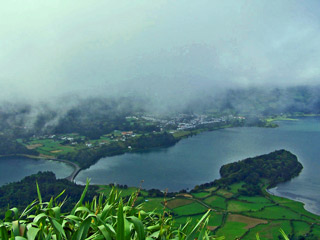
It's a compelling sensory
experience from the viewpoint at Miradouro do Cerrado das
Freiras with hydrangeas and cryptomerias engulfing the
crater adding a colorful spirit to the luxuriant
plantings. The fog that skims the lakes, propelled by
breezes, coming and going, rising and dropping, causing
an array of changing scenes and colors as the sun moves
in and out, sets the mood for contemplation. This is a
special place - it is Sao Miguel, it is the Azores - this
is why we returned to Lagoa das Sete Cidades.
[Back
to Top]
Restaurante Arco da Velha, Rua dos Mercadores, 82a, Ponta Delgada is a newcomer to the city and this ancient shopping street. Before the artificial harbor was built and the harbor front boulevard Avenida Infante D. Henrique was created, the sea reached Rua dos Mercadores. The front of the restaurant is a narrow corridor of stone archways with limited seating. The main dining room to the rear was once the sea. The menu is refreshingly different offering not only the typical Azorean dishes but recipes from the mainland like Cataplana from the south and leitao from the central area.
Cataplana is the name of the copper pot in which various recipes of fish and shellfish, chicken or meat, vegetables and herbs are cooked. Tonight's offering was Cataplana de Cherne, one of our favorite varieties of fish. After spending 30 minutes in the oven, the copper pot with its hinged lid was presented to us. The lid was removed revealing the gorgeous sight and smell of the cherne, potatoes, peppers, onions, and bay leaves, spiked with a touch of piri piri. There were about 8 thick slices of fish with a comparable quantity of veggies. The order for two was enough for four, but we did it justice (you knew that!). No dessert - okay, we did have Magnum Classics while walking back to the hotel.
The next evening was Leitao night
and since the owner was originally from Mealhada in the
mainland, the kingdom of roast suckling pig, we made a
reservation. The leitao was roasted properly and had the
correct flavor, but the portions were small and Linda's
was more fat than meat. When we called it to their
attention they brought a few pieces that were less fatty.
Go for the Cataplana.
[Back
to Top]
The Museu Carlos Machado, in Ponta Delgada is a must visit for an in-depth
understanding of the history, culture and nature of
Azorean life. It is housed in the former Convent of Santo
Andre which is set on a luxurious property in the heart
of the city, with plantings from around the world in the
front garden. Originally the museum housed only the
Natural History collections of Carlos Maria Gomes Machado.
In 1914 the museum was named after Carlos Machado and the
collections expanded through acquisitions, gifts and
property from dissolved monasteries. 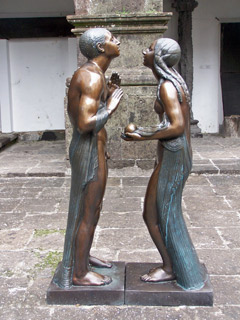
Entering the stone cloister we were immediately struck by a bronze sculpture of Adam & Eve by Canto da Maia (a replica of which is also inside) named, "hino do amor", in love. The form and facial expressions leave no doubt of the meaning. The artist was born in Ponta Delgada in 1890, died in 1981. His works are on display in Portugal and abroad.
The rooms off the cloister are dedicated to regional ethnography. A carefully reconstructed bedroom and kitchen, including models dressed in period clothing provide insight into daily life in rural Sao Miguel. This insight is further enhanced in other rooms with exhibits of toys, crafts, ceramics, pottery, detailed miniature homes, dolls depicting costumes and customs, and agricultural and nautical implements emphasizing the farming and fishing heritage. The Church of Santo Andre and other convent rooms can be visited on this main level.
The 1st floor is devoted to an art collection representative of 15th-20th c. sculpture, goldsmith, and ivory work. The art is reflective of the history of the people and the land with wonderful portraits and landscapes of island scenes. There are a couple ancient pianos on display, one of which has vertical strings behind the keyboard.
The adjoining building houses the fabulous Natural History Collection. A preserved sample of every fish, animal, bird, insect, butterfly, etc. that has ever inhabited the Azores is on display as well as pictures, graphs, charts and detailed explanations. It's a scientific reflection of nature's impact and influence on the Azores during the 19th century. The Carlos Machado Museum is a "must see".
A short distance away in Largo do Colegio is the Jesuits College Church, the Sacred Art Centre of the Museum Carlos Machado, which visit is included with entrance to the main museum. The art collection is sensational with paintings and sculptures from the 17th and 18th centuries displayed in the nave and sacristy. Particularly impressive is the huge woodcarving of the altar piece on the high altar, perhaps the largest of its type in Portugal.
It was a lovely day for a stroll in the park and what better place than the Municipal Park or the Antonio Borges Botanical Gardens just a bit west of Largo do Colegio. The pathways lead through exotic plantings mainly from Australia and New Zealand which have grown to remarkable size, particularly an enormous rubber tree. Picturesque artificial grottos of red volcanic rock, belvederes, lakes, walls and tunnels have been interwoven to lend a romantic touch.
The distance from the north coast between Capelas and Ribeira Grande across the island to Ponta Delgada is just 11-15 kilometers. Combine that with the micro climate of the area and it's easy to understand its popularity with those that work in Ponta Delgada who prefer to live in a rural environment.
The walled manor houses of Capelas
reflect a certain prosperity enjoyed during the 19th
century. Down at the harbor an old landing and factory
hearken to the times that local whalers were out there
catching sperm whales and bringing them home for
processing. 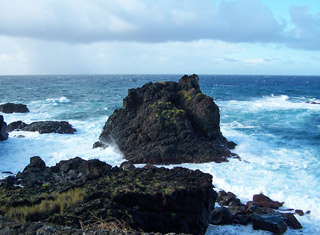
As we drove, we had to make
frequent stops to admire the sight and sounds of the
waves smashing against the rocky lava coastline. Ana
suddenly made a few turns and pulled up in front of an
adorable yellow house sitting in the middle of a well-tended
garden. She surprised us with a visit to her home in the
village of Calhetas. As is the custom we sat in the
kitchen and enjoyed a local liqueur and brandy carefully
mixed to reduce the sweetness, delicious, as was Ana's
gesture.
[Back
to Top]
Just east of Calhetas is Rabo de Peixe where Ana introduced us to Maria and Joao Galvao owners of the agriturismo, Quinta de Santana. A small building serves as a cozy lounge complete with a billiard table, honor bar and internet point. Accommodations include double rooms and apartments situated amongst gardens, fruit trees and a pretty pool area. It's a delightful rural living experience.
A last walk through Ponta Delgada before leaving for the airport took us along Rua de Sao Joao which has some wonderful 18th and 19th century homes decorated with the creative wrought ironwork of the Ponta Delgada craftsmen. On the site of a former convent is the well-preserved Teatro Micaelense reminiscent of movie theatres of the fifties.
Rua de Sao Joao becomes Rua deo Mercado, home to the Mercado, a combination of social scene and serious shopping venue. Markets are always a fun place and this was no exception. At the entrance are two cheese stores with a delectable array of all the cheeses produced in the archipelago. At the fish section we finally solved our biggest problem, what to call those tiny fish that are battered and fried, picked up and eaten whole (except for those of us who do remove the head). Carapau is the most familiar name, but they can also answer to mackerel or chicharro. Fresh grown produce and meat, home baked bread and pastries - someday we'll be back and stay long enough to do a little home cooking and eating.
Factoid: the sidewalk of each street in the city has its own black and white stone design to enable men to find their way home after an evening of liquid refreshment. The attractive sidewalks in the main square behind the magnificent city gates have economic symbols of the island such as pineapple and wheat.
Speaking of the main square, Praca Goncalo Velho Cabral, which we wrote about in our 2003 travelogue, remains one of our favorites. The arcades, the high archways of the city gates, the Parish Church of Sao Sebastiao, the streets and sidewalks, all in the traditional black and white design of the Azores create a striking, memorable impact.
We stopped to have a final coffee at the popular Cafe Clipper, Rua Machado Santos, 28. Ana knew all the patrons, as she did in the Mercado. They all wished us well and a safe journey home. Strangers become friends very easily out here in the middle of the Atlantic - another good reason to return.
The Ponta Delgada airport was quite
busy with flights leaving for the other islands and the
mainland. SATA handled it all quite efficiently and we
were off for Toronto promptly at 16:30. Once again the
flight crew was polite, cheerful and efficient. The food
and beverage service was excellent. The six hour flight
flew by and with only that four hour time difference we
were back to normal in short order, with a new story to
tell, which we hope you've enjoyed.
[Back
to Top]
Porto | Cascais
| Portel
| Lisboa
São Miguel, Azores
Search TheTravelzine | TheTravelzine Group | Don's Gallery
Packing Hints | Planning
Tips | Cities
Links
All pages on TheTravelzine.com©Copyright 1996-2020 Don & Linda Freedman